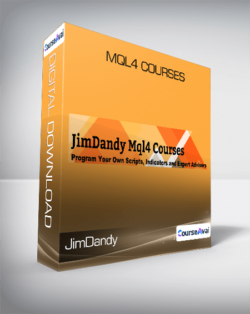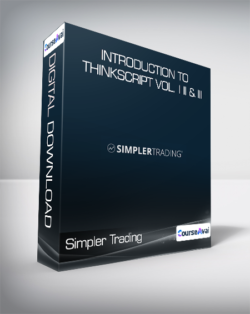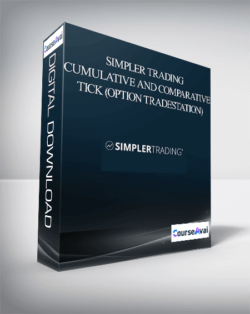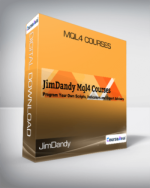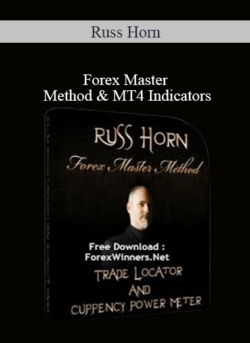Module 1The BasicsUnit 1A Look Around the “New” MetaEditorUnit 2Precompiler Lines and the FrameWork of Our CodeModule 2610 Functions Explained and the DebuggerPurchase JimDandy – Mql4 Courses courses at here with PRICE $247 $48JimDandy – Mql4 CoursesModule 1Module 1The BasicsUnit 1A Look Around the “New” MetaEditorUnit 2Precompiler Lines and the FrameWork of Our CodeModule 2610 Functions Explained and the DebuggerUnit 1How a Function is WrittenUnit 2Calling a FunctionUnit 3DebuggerModule 3610 Variables and Data TypesUnit 1Variables and Data TypesUnit 2Integers, Bytes, Bits? How a Computer Stores NumbersUnit 3Keeping Time With DateTime and OnTimer()Unit 4Working With the Color Integer Data TypeUnit 5Creating Our Own Integer Data Types with EnumerationsUnit 6Boolean Type IntegersUnit 7Floats,Doubles and StringsUnit 8Global Scope, Local Scope and Static VariablesUnit 9Extern or Input?Module 4OperationsUnit 1Arithmetic OperationsUnit 2Assignment OperationsUnit 3Relation OperationsUnit 4Boolean OperationsUnit 5Ternary OperatorUnit 6Switch OperatorUnit 7While and Do While Loop OperatorsUnit 8For Loop OperatorModule 5Object Oriented Programming Basics: Structures and Classes.Unit 1StructuresUnit 2Structures…Classes…Necessary?Unit 3ConstructorsUnit 4DestructorsUnit 5Classes, Setters and GettersUnit 6Encapsulation, Extensibility, Overloading, PolyMorphism?Unit 7Using the Mql4 Wizard to Create a ClassUnit 8InheritanceUnit 9OOP Conclusion and CommentaryGet JimDandy – Mql4 Courses downloadModule 2Module 1So What’s a Script and How Do We Make One?Unit 1What is a Script?Unit 2Daily Range ScriptModule 2MessageBox A Useful ToolUnit 1Introduction to MessageBoxUnit 2Message Box FlagsUnit 3#Defines and the Hexadecimal SystemUnit 4Using MessageBox to Choose Our PathModule 3Getting Our Attention with Email and Push NotificationsUnit 1Sounding an AlertUnit 2Email and Push NotificationsModule 4Knowledge Is Power (Gathering Information)Unit 1Gathering Information Using Pre Defined Variables.Unit 2MarketInfo() Function Part1Unit 3MarketInfoFunction() Part2Unit 4AccountInfoModule 5Order Management Using ScriptsUnit 1Sending Orders With ScriptsUnit 2Selecting an Order For ModificationUnit 3Error Checking in Our CodeUnit 4Placing Pending OrdersUnit 5Buying/Selling Scripts and Point/Pip Explained.Unit 6Drag And Drop ScriptsUnit 7Deleting Pending OrdersUnit 8Using a For Loop to Delete OrdersUnit 9Closing Market Orders (Trades)Module 3Module 1Indicators And The Arrays That Make Them PossibleUnit 1Custom Indicator IntroductionUnit 2The Simplest Indicator and Where It Comes FromUnit 3Series ArraysUnit 4Array Functions ExplainedModule 2How To Write the Code For an IndicatorUnit 1How Indicators Become Part of the Chart.Unit 2Making the Indicator Display at a Specific Place On the Chart.Unit 3The New OnCalculate FunctionUnit 4Drawing With Loops and Array Out of RangeUnit 5Putting Logic Into Our IndicatorModule 3Moving our Indicator to a Separate WindowUnit 1Putting An Indicator in a Separate WindowUnit 2Setting Properties During OnInit Instead of Using Pre-Compiler Lines.Module 4Working With Technical IndicatorsUnit 1Technical Indicators Save A Lot of CodingUnit 2Let’s Make an MAUnit 3Setting up MaCross GraphicsUnit 4Setting Up MaCross LogicModule 5Putting Controls in Our IndicatorsUnit 1Putting Settings In Our MA Cross SignalUnit 2Bollinger Band SignalsUnit 3Fixing Array Out of Range Part 1Unit 4Fixing Array Out of Range Part 2Unit 5Putting in the NotificationsModule 6Combining Indicators into One SignalUnit 1Bollinger Stochastic Combo Part 1Unit 2Bollinger Stochastic Combo Part 2Module 7How To Call a Custom IndicatorUnit 1Calling Custom Indicators Part 1Unit 2Calling Custom Indicators Part 2Unit 3Calling Custom Indicators Part 3Module 8Special Multi-Colored Full Adjustable Macd IndicatorUnit 1Our Oscillator Part 1Unit 2Our Oscillator Part 2Unit 3Our Oscillator Part 3Unit 4Our Oscillator Part 4Module 4Module 1Making it Idiot Proof and Controlling AccessUnit 1Starting From the BeginningUnit 2Checking Our SettingsUnit 3Password ProtectionUnit 4Your Expert Can Close Itself!Unit 5Code that will expire.Module 2The Basic FoundationUnit 1The Mandatory Components of a Basic EAUnit 2Reviewing The Basic ComponentsModule 3Using iCustom To Call Your IndicatorUnit 1How to Call a Custom Indicator With iCustom()Unit 2Calling With Custom ParametersUnit 3Multiple TimeFrame ProblemsUnit 4Custom Indicator Calling Tool and DEMA EAUnit 5Practice Your Trigger CodingModule 4Adding More Functionality to Our Basic EAUnit 1Auto-Generating Our MagicNumbersUnit 2Adding Move to BreakEvenUnit 3Adding a Trailing StopUnit 4Adding a Candle (Swing High/Low) StopUnit 5Solving Stoploss Coding ProblemsUnit 6Moving Indicator Code Into Our Expert AdvisorModule 5Controlling the Opening and Closing Of TradesUnit 1Limiting Number of Orders and Checking if Hedging is AllowedUnit 2Closing On Opposite SignalUnit 3Closing Trades On a FIFO Compliant PlatformModule 6Martingaling The Two-Edged SwordUnit 1MartingalingUnit 2Market Trapper Part 1Unit 3Market Trapper Part2Module 7Controlling a Sequence of TradesUnit 1Using Trade Comments to Identify TradesUnit 2Knowing When to Quit TradingUnit 3An OnScreen Display to Monitor Our SituationUnit 4Setting Lotsize For Each Trade in The Sequence.Module 8Basket TradingUnit 1Introducing Basket TradingUnit 2Coding a MACD TriggerUnit 3Controlling our Trade SpacingUnit 4The Math of “Cost Averaging”Unit 5Closing All Trades TogetherUnit 6Using a Auto-Mild MartingaleUnit 7Manual MartingaleUnit 8BasketTrader SmartingaleUnit 9Displaying the Basket BreakevenUnit 10Basket Trader Finished.Unit 11Concluding RemarksPurchase JimDandy – Mql4 Courses courses at here with PRICE $247 $48

